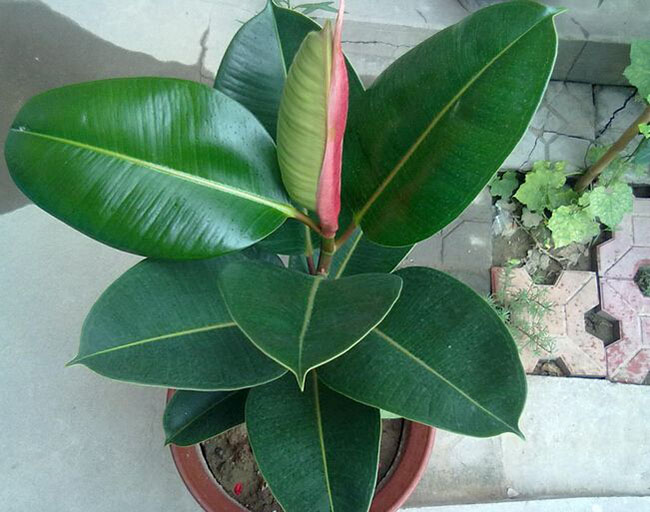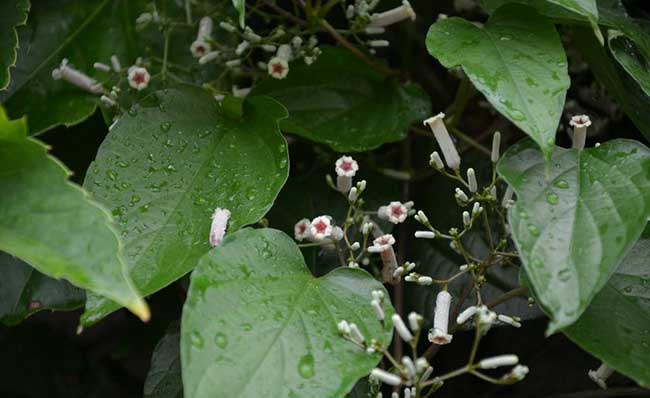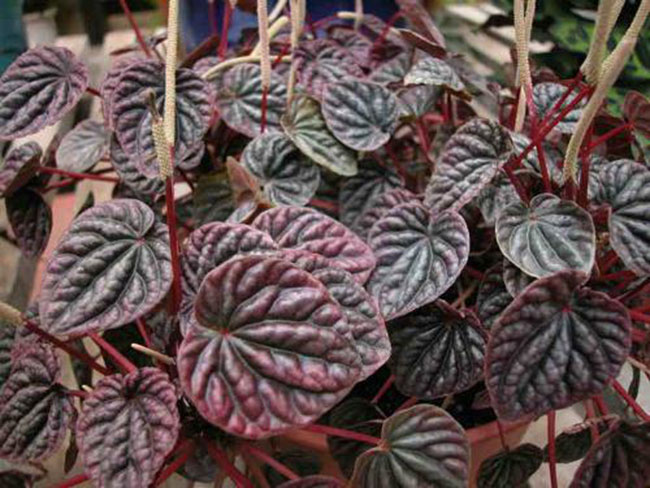Culture methods and propagation of Indian rubber trees
Indian rubber tree
Achene ovoid, with small tumors on the surface, style long, persistent, stigma dilated, subcapitate. Flowering in winter. Originated from Bhutan, Sikkim, Nepal, Northeast India (Assam), Myanmar, Malaysia (northern), Indonesia (Sumatra, Java). China's Yunnan (Ruili, Yingjiang, Lianshan, Longchuan) is wild at 800-1500 meters.

Morphological characteristics of Indian rubber tree
Trees, to 20-30 m tall, 25-40 cm DBH; bark gray-white, smooth; epiphytic when young, branchlets stout. Leaves thickly leathery, oblong to elliptic, 8-30 cm long and 7-10 cm wide, apex acute, base broadly cuneate, entire, surface dark green, bright, abaxially light green, lateral veins numerous, inconspicuous, parallel exhibited; petiole stout, 2-5 cm long; stipules membranous, crimson, up to 10 cm long, with obvious annular scar after shedding. Figs are paired in leaf axils of deciduous branches, ovate-long-oval, 10 mm long, 5-8 mm in diameter, yellowish green, basal bracts cap-shaped, with a ring at the base after shedding; male flowers, gall flowers, female flowers co-growing on the inner wall of figs; male flowers stipitate, scattered in the inner wall, tepals 4, ovate, stamens 1, anthers ovoid, without filaments. Gall flowers: tepals 4, ovary smooth, ovoid, style subterminal, curved; female flowers sessile. Achene ovoid, with small tumors on the surface, style long, persistent, stigma dilated, subcapitate. Flowering winter
Distribution range of Indian rubber trees
Originated from Bhutan, Sikkim, Nepal, Northeast India (Assam), Myanmar, Malaysia (northern), Indonesia (Sumatra, Java). Yunnan (Ruili, Yingjiang, Lianshan, Longchuan) is wild at 800-1500 m.
Indian rubber tree growing environment
Sex likes high temperature, humid, sunny environment, but also can withstand shade but not cold. Suitable growth temperature 20 ℃ 25 min, avoid direct sunlight. Can also endure shade but not cold, safe overwintering committee immediately tail 5 ℃. Resistant to air dryness. Avoid clayey soil, do not tolerate barren and drought, prefer loose, fertile and slightly acidic soil with good drainage.
Propagation methods of Indian rubber trees
The main propagation methods of Indian rubber trees are cutting and striping. Cutting is relatively simple, and the survival rate and growth rate of rubber trees are also relatively high. Generally speaking, rubber tree cutting is mainly carried out in late spring and early summer combined with pruning. The sturdy branches in the middle of the rubber tree were selected as cuttings, and the cuttings retained three buds, and the glue at the front of the cuttings should be condensed, or some charcoal ash and rice chaff ash could be selected and dried, and then cut on the cutting bed with river sand or vermiculite as substrate to keep the growth environment of the cuttings between 18-25 ℃. The cuttings can take root in about 30 days. When the cuttage rubber tree has two leaves, it can be transplanted into the pot.
The survival rate of rubber tree propagation under high pressure is very high.
Selection of cultivation soil for Indian rubber trees
Potted peat soil, rotten leaf soil plus 1x4 river sand and a small amount of base fertilizer can also be used as fine sand. Rubber trees grow faster and like to be fertilized once a week. Usually change pots or soil before new shoots grow in spring. When the seedlings are 80 cm ~ 100 cm high, coring can promote the germination of lateral branches as needed. Usually leave 3 main branches and get rid of the other redundant branches. If cultivated for 3 years or so, it can grow into a large plant of 2 meters.
Rubber trees like strong sunshine from spring to autumn. The whole festival season is planted in the sun. In winter, it should also be placed in the place with the strongest sunshine indoors. If you put it indoors and watch it, you can't change it for too long every 2 weeks or so. Rubber trees grow very fast in high wet and humid environments and produce a leaf every 5 to 7 days. Adequate fertilizer and moisture must be ensured during this period. In autumn, fertilization and watering are gradually reduced to promote the growth and fullness of branches.
Because rubber trees have strong resistance to dry environment, it is easier to cultivate in North China. It should be kept in a room above 10 ℃. Long-term low temperature and damp basin soil can easily cause root rot. Move to outdoor cultivation from the end of April to the beginning of October every year
Culture methods of Indian rubber trees
1. Temperature
Like warmth, the most suitable temperature for growth is 20-25 °. It is resistant to high temperature and can grow well when the temperature is above 30 °. The cold tolerance of variegated leaf varieties with 5 °overwintering temperature was slightly worse, and the overwintering temperature was better maintained above 8 °0. A large number of fallen leaves will be produced when the temperature is low.
2. Lighting
Like bright scattered light, have a certain ability to withstand shade. Can not bear the exposure of strong sunlight, when the light is too strong, it will burn the leaves and appear yellowing and scorched leaves. Should not be too overcast, otherwise it will cause a large number of fallen leaves and dilute the beautiful patches of variegated varieties. From May to September, shade should be provided, or the plant should be placed in a place with sufficient scattered light. The rest of the time should be given plenty of sunshine.
3. Watering
Like the moist soil environment, the growth period should be fully supplied with water to keep the basin soil moist. Watering needs to be controlled in winter. when the basin soil is too wet at low temperature, it will easily lead to root rot.
4. Environmental humidity
Like the humid environment, when the growing season is sunny and the air is dry, you should often spray water to the branches and leaves and the surrounding environment to improve the relative humidity of the air.
5. Fertilization
Because of the rapid growth, nutrients should be supplied in time to make the plant flourish and grow. Nitrogen-based fertilizer should be applied 2-3 times a month. The species with colored markings grow slowly, which can reduce the number of fertilization and increase the application of potash fertilizer to make the speckle color on the leaf surface bright. If excessive or simple application of nitrogen fertilizer, the color of the markings will become lighter, or even disappear. In September, the application of nitrogen fertilizer should be stopped and only phosphorus and potassium fertilizer should be applied to improve the cold resistance of the plant. Plant dormancy in winter, fertilizer should be stopped.
6. Pruning
If the crown is too large, the outer branches can be truncated as a whole. Dense branches and short truncated branches should be removed at any time during growth.
7. Turn the basin
The basin usually needs to be turned once every 2 years. Like the sandy loam with fertile, loose and good drainage, the matrix can be prepared with garden soil, rotten leaf soil and plain sand, and mixed with farm manure as base fertilizer.
8. Pest control
There are leaf spot disease and red spider, banyan thrips, shell insects and other diseases and insect pests.
How to raise Indian rubber trees? how to raise Indian rubber trees?
Indian rubber tree is a tropical tree species, its leaves are bright, evergreen all the year round, is a very common foliage tree species, so many people like to put its potted plants in the living room or bedroom, so as to add a little green and vitality to the room. For the growing environment, rubber trees like warm and wet, but also like the sun, its best growth temperature is between 20 and 25 ℃. Potted plants are widely planted in China. The following editor gives you a brief introduction to the breeding methods of Indian rubber trees.
Reproduction method
The main propagation methods of Indian rubber trees are cutting and striping. Cutting is relatively simple, and the survival rate and growth rate of rubber trees are also relatively high. Generally speaking, rubber tree cutting is mainly carried out in late spring and early summer combined with pruning. The sturdy branches in the middle of the rubber tree were selected as cuttings, and the cuttings retained three buds, and the glue at the front of the cuttings should be condensed, or some charcoal ash and rice chaff ash could be selected and dried, and then cut on the cutting bed with river sand or vermiculite as substrate to keep the growth environment of the cuttings between 18-25 ℃. The cuttings can take root in about 30 days. When the cuttage rubber tree has two leaves, it can be transplanted into the pot.
The survival rate of rubber tree propagation under high pressure is very high. When pressing the strips, it is best to choose the branches that grow in the second year. First, the branches of the rubber tree are girdled and peat, then wrapped in moist moss or plastic film or peat soil. After the rubber tree takes root, the branches that take root are cut off and loaded into the soil to grow into a new rubber tree.
Maintenance method
Indian rubber trees like to be fertile, and new seedlings need a lot of nutrients, so fat, loose and humus-rich sandy loam, rotten leaf soil and garden soil should be selected as culture soil. in addition, a small amount of cake fertilizer should be applied as base fertilizer during seedling growth to ensure soil fertility. Rubber trees avoid nitrogen fertilizer. When there is too much nitrogen fertilizer, the plant shape of rubber trees is not beautiful, so they should apply less nitrogen fertilizer.
Indian rubber trees like to be wet and need more water in summer. When breeding, we should pay attention to watering the rubber tree every day and increase the number of times of drying under the premise of ensuring that the potted soil is moist. It is worth reminding that Indian rubber trees avoid waterlogging and are not resistant to drought. when rubber trees are maintained in winter, the soil can be moist.
As a tropical tree species, Indian rubber tree has strict requirements on light and temperature. Rubber trees like light, from spring to autumn should be placed outside the sun to maintain, if placed in indoor breeding for a long time, it is very easy to cause rubber tree leaves yellowing and falling off. After winter, when the temperature drops sharply, the rubber tree should be moved to the sunny place indoors for maintenance, pay attention to the indoor temperature should be kept above 10 ℃, and then move the rubber tree to outdoor maintenance at the end of April and the beginning of May when the annual temperature rises.
After the rubber tree is transplanted into the pot, you should pay attention to turning the soil for the flowerpot. Generally speaking, it is best to turn the soil when the rubber tree grows new buds in spring every year. When the rubber tree grows too big, it can also replace a larger flowerpot for the rubber tree.
Conclusion: the above is the Indian rubber tree how to raise, Indian rubber tree breeding method, the companions who love Indian rubber tree might as well give it a try. The growing Indian rubber tree is green all over, and it can not only green the environment but also purify the air in the living room and studio. Why not do it?
So can Indian rubber trees be kept indoors? Will it hurt the human body to keep it indoors? And what is the culture method of Indian rubber trees? The following editor will answer these questions for you one by one. The value and function of Indian rubber tree the value of Indian rubber tree is reflected in its ornamental value and function. The sap of Indian rubber trees is also the raw material for making rubber.
In the market, we can see that there are many places where small and medium-sized potted plants of Indian rubber trees are sold, and we can choose according to our own needs. The living habits of Indian rubber trees Indian rubber trees like to grow in a warm, humid, sunny environment and are not resistant to cold, so it is difficult for Indian rubber trees to survive in colder environments. In addition, Indian rubber trees prefer fertilizer, so it is best to choose fertile soil to plant Indian rubber trees.
The propagation method of Indian rubber tree bonsai Indian rubber tree Indian rubber tree propagates mainly by cutting and can also be propagated by striping method. It is appropriate to propagate Indian rubber tree by cutting from May to September. When cutting, select 1-2-year-old Indian rubber tree branches according to 3-4 sections of each section for cutting. it should be noted that cooked lime powder or plant ash should be applied immediately on the cut branch section, and press tightly with thumb for three to five minutes to prevent the loss of juice. One or two leaves should be left on each branch to facilitate better cutting. In addition, the cutting temperature should be kept above 15 ℃. The culture method of Indian rubber tree is the same as that of rubber tree, and they are often planted indoors for potted plants. Potted rubber trees should be cultured in semi-shade during their seedling period. When Indian rubber tree seedlings are cultured, in order to make them grow better, the pots should be changed every spring. The adult plants grow slowly and can be changed every 2-3 years. When changing the basin, the old disease root should be cut off, and the basin soil should be replaced.
In addition, rubber tree seedlings should be rotated regularly to prevent them from growing obliquely to one side and reduce their ornamental value. Rubber trees prefer fertilizer and water, so they must be given enough fertilizer and water in the peak growing season to ensure their luxuriant growth and thick green leaves. Usually to keep the basin soil moist, high temperature season every morning and evening each watering, and often spray water to the branches and leaves, otherwise the rubber leaf edge is easy to scorch. Rubber trees like the sun, be sure to give them enough light when raising them, but shade them when the sun is strong in summer. Low temperature is not conducive to the growth of rubber trees, so when raising rubber trees in winter, it is best to ensure that the growth environment temperature is about 10 ℃, and the temperature is not lower than 3 ℃, otherwise the leaves of rubber trees will turn yellow and fall off.
Control of Botrytis cinerea of Indian rubber trees cultivated in courtyard Botrytis cinerea is a common disease of Indian rubber trees. after infection, the new leaves of rubber trees will die and the old leaves will rot off. In order to prevent the occurrence of Botrytis cinerea in Indian rubber trees, attention should be paid to the fact that rubber trees should not be too crowded after moving into the greenhouse in winter, and the temperature difference between day and night should not be too large. Water should be poured from the edge of the basin, not with a rubber hose. Timely removal of diseased leaves, diseased fallen leaves and diseased shoots to reduce the source of infection. Conclusion: Indian rubber trees can play a good role in decoration indoors, and friends in need can raise them indoors. Indian rubber tree culture methods Xiaobian introduced so much, I hope to help you.
- Prev

Culture methods and matters needing attention of Tripterygium wilfordii
The morphological characteristics of Tripterygium paniculata are herbaceous vines. Branchlets Terete, longitudinally ribbed, often glaucous, glabrous. Tendrils 2-branched, interspersed with leaves at intervals of 2 segments. The leaves of Tripterygium wilfordii are cordate-ovoid, 5-13 cm long and 4-9 cm wide, apex acute or acuminate, base cordate.
- Next

Culture methods and efficacy of Capsicum rugosa
The growing environment of Zanthoxylum bungeanum likes half-day light or bright scattered light. The suitable temperature for growth is 25-28 ℃, and the overwintering temperature should not be lower than 12 ℃. Like warm and humid environment and well-drained sandy loam, not resistant to stagnant water, but like the environment with high air humidity. Morphological characteristics of Rabdosia angustifolia; fascicled plants with short stems
Related
- Fuxing push coffee new agricultural production and marketing class: lack of small-scale processing plants
- Jujube rice field leisure farm deep ploughing Yilan for five years to create a space for organic food and play
- Nongyu Farm-A trial of organic papaya for brave women with advanced technology
- Four points for attention in the prevention and control of diseases and insect pests of edible fungi
- How to add nutrient solution to Edible Fungi
- Is there any good way to control edible fungus mites?
- Open Inoculation Technology of Edible Fungi
- Is there any clever way to use fertilizer for edible fungus in winter?
- What agents are used to kill the pathogens of edible fungi in the mushroom shed?
- Rapid drying of Edible Fungi

